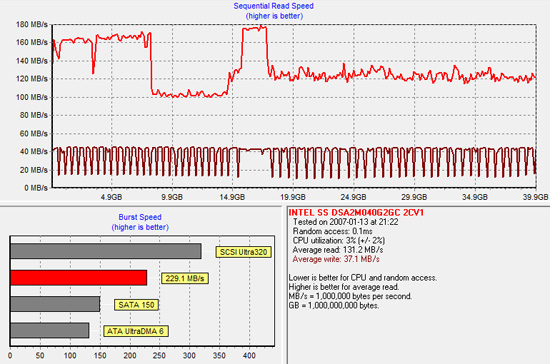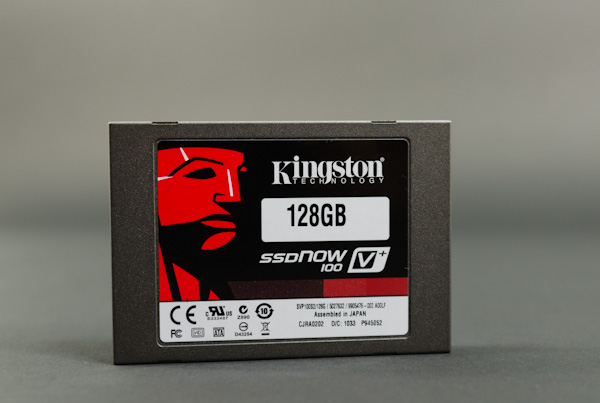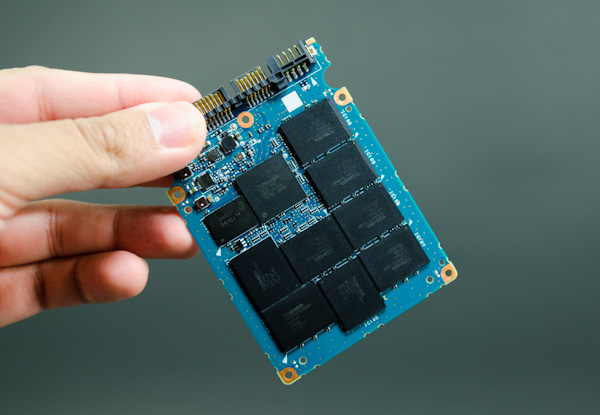Kingston SSDNow V+100 Review
by Anand Lal Shimpi on November 11, 2010 3:05 AM EST- Posted in
- Storage
- SSDs
- Kingston
- SSDNow V+100
I'm not sure what it is about SSD manufacturers and overly complicated product stacks. Kingston has no less than six different SSD brands in its lineup. The E Series, M Series, SSDNow V 100, SSDNow V+ 100, SSDNow V+ 100E and SSDNow V+ 180. The E and M series are just rebranded Intel drives, these use Intel's X25-E and X25-M G2 controllers respectively with Kingston logo on the enclosure. The SSDNow V 100 is an update to the SSDNow V Series drives, both of which use the JMicron JMF618 controller. Don't get this confused with the 30GB SSDNow V Series Boot Drive which actually uses a Toshiba T6UG1XBG controller, also used in the SSDNow V+. Confused yet? It gets better.
The standard V+ is gone and replaced by the new V+ 100, which is what we're here to take a look at today. This drive uses the T6UG1XBG controller but with updated firmware. The new firmware enables two things: very aggressive OS-independent garbage collection and higher overall performance. The former is very important as this is the same controller used in Apple's new MacBook Air. In fact, the performance of the Kingston V+100 drive mimics that of Apple's new SSDs:
| Apple vs. Kingston SSDNow V+100 Performance | ||||||
| Drive | Sequential Write | Sequential Read | Random Write | Random Read | ||
| Apple TS064C 64GB | 185.4 MB/s | 199.7 MB/s | 4.9 MB/s | 19.0 MB/s | ||
| Kingston SSDNow V+100 128GB | 193.1 MB/s | 227.0 MB/s | 4.9 MB/s | 19.7 MB/s | ||
Sequential speed is higher on the Kingston drive but that is likely due to the size difference. Random read/write speed are nearly identical. And there's one phrase in Kingston's press release that sums up why Apple chose this controller for its MacBook Air: "always-on garbage collection". Remember that NAND is written to at the page level (4KB), but erased at the block level (512 pages). Unless told otherwise, SSDs try to retain data as long as possible because to erase a block of NAND usually means erasing a bunch of valid as well as invalid data and then re-writing the valid data again to a new block. Garbage collection is the process by which a block of NAND is cleaned for future writes.

Diagram inspired by IBM Zurich Research Laboratory
If you're too lax with your garbage collection algorithm then write speed will eventually suffer. Each write will eventually have a large penalty associated with it, driving write latency up and throughput down. Too aggressive with garbage collection and drive lifespan suffers. NAND can only be written/erased a finite number of times, aggressively cleaning NAND before it's absolutely necessary will keep write performance high at the expense of wearing out NAND quicker.
Intel was the first to really show us what realtime garbage collection looked like. Here is a graph showing sequential write speed of Intel's X25-V:

The almost periodic square wave formed by the darker red line above shows a horribly fragmented X25-V attempting to clean itself up at every write. Eventually, with enough writes, the X25-V will return to peak performance. At every write request the X25-V controller will attempt to clean some blocks and return to peak performance. The garbage collection isn't seamless but it will eventually restore performance.
Now look at Kingston's SSDNow V+100, both before fragmentation and after:


There's hardly any difference. Actually the best way to see this in work is to look at power draw when firing random write requests all over the drive. The SSDNow V+100 has wild swings in power consumption during our random write test ranging from 1.25W to 3.40W. The swings would happen several times in a window of a couple of seconds. The V+100 is aggressively tries to reorganize writes and recycle bad blocks, more aggressively than we've seen from any other SSD.
The benefit of this is you get peak performance out of the drive regardless of how much you use it, which is perfect for an OS without TRIM support - ahem, OS X. Now you can see why Apple chose this controller.
There is a downside however: write amplification. For every 4KB we randomly write to a location on the drive, the actual amount of data written is much, much greater. It's the cost of constantly cleaning/reorganizing the drive for performance. While I haven't had any 50nm, 4xnm or 3xnm NAND physically wear out on me, the V+100 is the most likely to blow through those program/erase cycles. Keep in mind that at the 3xnm node you no longer have 10,000 cycles, but closer to 5,000 before your NAND dies. On nearly all drives we've tested this isn't an issue, but I would be concerned about the V+100. Concerned enough to recommend running it with 20% free space at all times (at least). The more free space you have, the better job the controller can do wear leveling.












96 Comments
View All Comments
melgross - Thursday, November 11, 2010 - link
So, with all of this info presented, which drives would be best as a Photoshop scratch drive?Out of Box Experience - Tuesday, November 16, 2010 - link
Any modern platter based drive should be fine for a photoshop scratch driveKlober - Thursday, November 11, 2010 - link
This is my perspective from what I see throughout the review:The Corsair Force drives and the Crucial RealSSD drives are very close performance-wise in most of the comparisons; however, when price is included in the scenario the Corsair Force drives (60GB/120GB) win hands down.
The only true advantage the C300 has over the Force drives from what I can tell is in scenarios where the data is mostly uncompressible - I don't think this comes close to making up for the price disadvantage of the C300 drives since most likely users will have a large mechanical drive for their storage drive rather than opting to use their C300 for that purpose.
Taking into account the fact that you can get the Corsair Force 60GB SSD for $5 more than the 40GB at NewEgg, I would say that pretty much nullifies the cost/GB advantage of the C300 at the lower capacity - at that point you're looking at $2.109/GB for the C300 and $2.031/GB for the Force 60GB assuming it has 64GB NAND capacity (that's going by dividing the Force 120GB specs in half...if we instead use the specs from the Force 40GB that would put the Force 60GB at an amazing $1.805/GB for a low capacity SSD!).
If I were to buy an SSD tomorrow it would almost definitely be the Corsair Force 60GB for its fantastic (at least by SSD standards) cost/capacity at a low price point.
Anyway, that's my 2 cents!
Aikouka - Thursday, November 11, 2010 - link
Why are you assuming the Corsair drive magically has more space than it actually lists? If it's a 60GB drive, then you only get 60GB of usable space with some other amount set aside as a scratch area.Personally, I base my purchases more on random read than anything. Based on the prices, I'd most likely pick up the Crucial C300 64GB if I was looking for a new boot drive.
7Enigma - Thursday, November 11, 2010 - link
Just a simple request for a G2 80gig Intel drive for future reviews. I think many of us have one of these and know the 160gig drive is significantly faster in some tests (sequential write), but almost identical in others (random read I believe).DanNeely - Thursday, November 11, 2010 - link
Are there any tools available that will let you see how much of the write capacity of an SSD you've exhausted?Iketh - Thursday, November 11, 2010 - link
i own an intel 40gb and intel's trim software reports it... it's part of a drive's SMART data, so any SMART reading program should be able to tell you, but i could be mistakenMadMan007 - Thursday, November 11, 2010 - link
"Note that not all SandForce drives are created equal here. If a manufacturer doesn’t meet SandForce’s sales requirements, their drives are capped at a maximum of 50MB/s here. This is the case with the Patriot Inferno, although OCZ’s Agility 2 voluntarily enforces the limit."I understand there is the 'higher performance' Sandforce firmware (Vertex 2 vs Agility 2 for example) and the Agility 2-type firmware is the one that gets 'capped,' but what exactly do you mean by 'meet Sandforce's sales requirements'? Is this to say that the firmware the retail companies are licensed to use and able to ship is restricted based upon sales figres/order quantity, so that if say OCZ buys 100k SF controllers while Patriot only buys 10k, Patriot is limited in which firmware they are allowed to offer? If it's not that, what exactly do you mean? And most importantly how can we as end-users making a purchase determine this difference, is looking at IOPS all that's needed?
7Enigma - Thursday, November 11, 2010 - link
Anand,I didn't like the wording of the power consumption in terms of not being better at load than a mechanical hard drive. Just like your praise of Intel's hurry up and get idle (with turbo), all of these SSD's have an advantage in bursting and then getting idle.
I had mentioned it in a previous SSD article but what we really need is a moderated workload suite. Something like virus scan and total power draw during that time. While load voltages might be the same or higher for the SSD's, the total power consumption during that time will (should) be less. I think a virus scan is perfect on a normal system as it should take 10-20min and give a measureable difference between drives. Grab a laptop from one of your recent reviews (not an Atom or other super-slow mobile to prevent the SSD from waiting around), and measure the total power drawn over the scan.
This is less important in a desktop obviously but for the mobile crowd (whom sees the biggest benefit over the traditional laptop drives anyway) might just be one more criteria to help make a decision (or just show that it's the type of drive (mech/SSD) and not really differences between the SSD's themselves).
Glad to have a new SSD review though. I love reading these and am trying to justify upgrading from my 80gig Intel G2 drive that has been fantastic for the last year. The great thing about the SSD tech is that you can hand-me-down smaller capacity, slower drives and completely revolutionize an older system.
Thanks again.
JohnBooty - Thursday, November 11, 2010 - link
"Kingston ships the V+100 with a 3-year warranty and to Kingston's credit I haven't had any other drives die as a result of wearing out the NAND. Even if the V+100 has higher effective write amplification than the competition, your usage model will determine whether or not you bump into it."Anand,
Firstly, thank you for being the industry standard when it comes to articles about SSD. It's a favorite topic of mine and your articles have steered a lot of purchases in my personal and professional circles (and you haven't steered us wrong!)
My request...
One of the lingering questions about SSDs is how long they'll actually last in the real-world before the NAND is fried. When I see you mentioning that you've never actually fried any NAND, that seems like an opportunity for you to give it a shot and give the public some answers.
I'd love to see a "torture test" article where you run simulated workloads against SSDs 24/7 until they can't take any more writes, and report on the results.